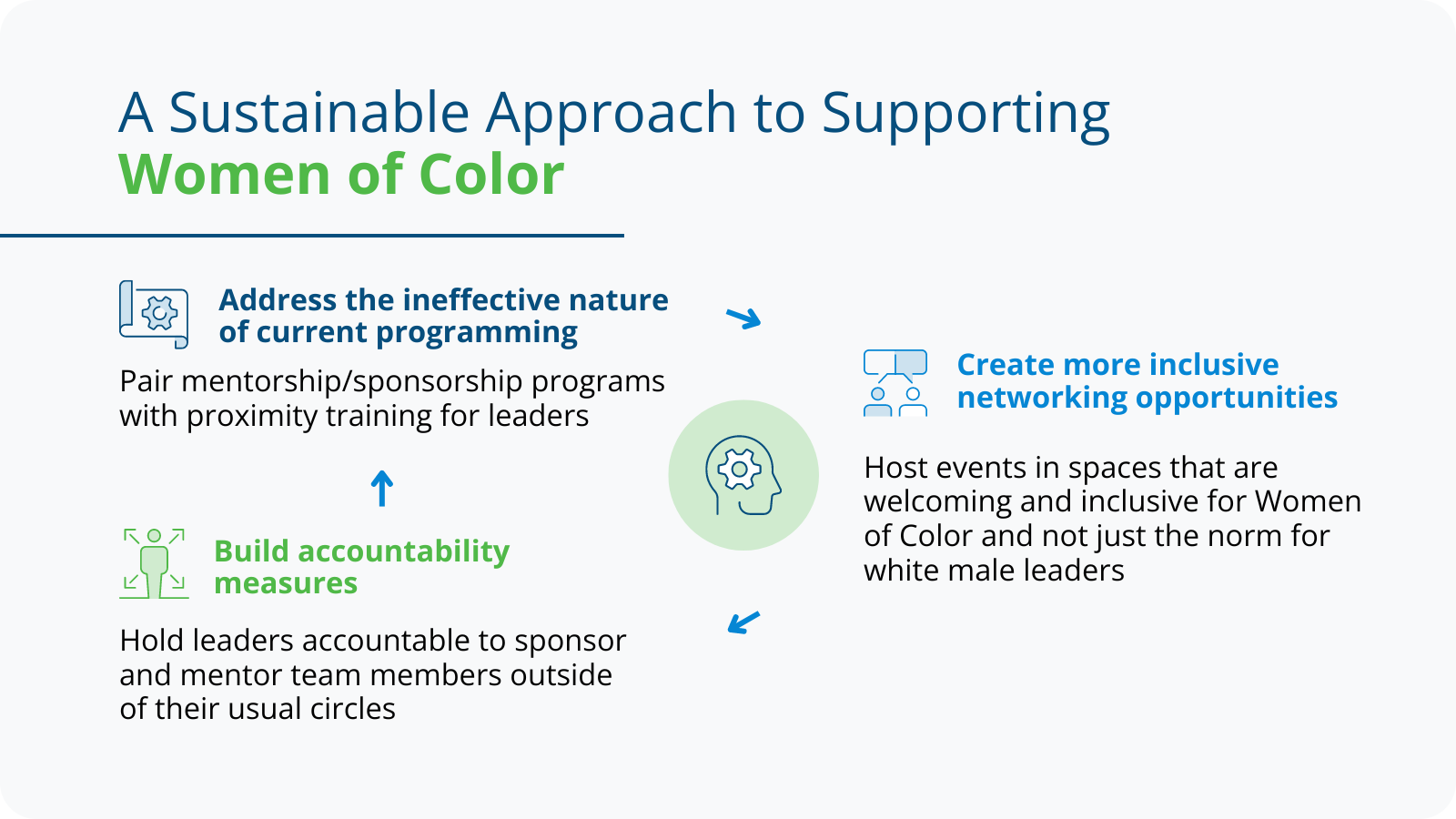Strategies to Enhance Career Networking for Women of Color in the Workplace

By: Esmé-Thea Sanders
 Esme-Thea Sanders (she/her) is an Engagement Leader in MLT’s Employer practice. She works closely with leaders to provide guidance on personalizing and owning their DEI commitments and strategies. Esme brings her two years DEI practitioner experience, and six years of experience delivering results for leaders. Prior to joining MLT, Esme worked on the Diversity, Inclusion and Belonging (DIB) team for Capital One’s Tech business. There she was responsible for DIB related learning and development, strategic alignment for business resource groups supporting 9,000 associates and DIB leadership coaching.
Esme-Thea Sanders (she/her) is an Engagement Leader in MLT’s Employer practice. She works closely with leaders to provide guidance on personalizing and owning their DEI commitments and strategies. Esme brings her two years DEI practitioner experience, and six years of experience delivering results for leaders. Prior to joining MLT, Esme worked on the Diversity, Inclusion and Belonging (DIB) team for Capital One’s Tech business. There she was responsible for DIB related learning and development, strategic alignment for business resource groups supporting 9,000 associates and DIB leadership coaching.
The intersection of Black History Month and Women’s History Month has provided a prime time to shine a light on a unique challenge faced by women of color: building career-enhancing networks. We often talk and read about the importance of networking in a successful career, but it is rare that we discuss why networking can be more challenging for women of color in corporate spaces. It’s important to acknowledge these challenges, dig below the surface to uncover their root causes, and work towards implementing sustainable solutions if we hope to see change.
At MLT, we define a career-accelerating network as the necessary support system that helps open doors and remove barriers in one’s professional career journey. This goes beyond simply connecting with the “right” people to surrounding oneself with capable and confident leaders who can influence and advocate on behalf of women of color. Drawing insights from our alumni surveys, partnerships, and external research, we have identified some key root causes contributing to these disparities experienced by women of color and devised a sustainable approach to address them.
Our investigation started with surveys conducted in 2021 and 2022 among MLT Alumni, a network comprising over 10,000 People of Color (Black, Latine, and Native American). Career-accelerating networks emerged as a key factor influencing the retention and sense of belonging of women of color in the workplace. The women of color in our survey reported lower rates of belonging and confidence in their ability to achieve their professional goals, in part due to their lack of career-accelerating networks within their organizations. To deepen our understanding, we engaged women of color from a partner organization to hear about their experiences in building or attempting to build such networks. The insights from these discussions were eye-opening and validated that these challenges were not unique to our Alumni and rising Fellows—individuals participating in MLT’s programs. These findings signal a broader systemic issue that extends beyond individual experiences.

Two primary root causes have been identified as major contributors to the differential networking experiences of women of color:
1. Organic Network Building
Many senior leaders assume that workplace relationships occur organically and effortlessly. In many cases, that’s how it worked for them, and they assume it must also work that way for everyone else. For many of these leaders, forming career-accelerating networks was a seamless process driven by shared interests and commonalities with their peers. However, for women of color, who occupy just 10% of senior manager and director-level roles and only 5% of C-suite positions, the dynamics of networking often look fundamentally different. This disparity often leaves White male leaders largely in charge of where and how younger employees can form career-accelerating networks. These decisions, often made subconsciously, can inadvertently create barriers for women of color to actively participate in network building.
2. Organizational Blind Spots
Organizations often remain unaware of the trade-offs required for women of color to navigate networking. For women of color in particular, forming professional relationships with leaders and other colleagues can involve mental, emotional, and physical trade-offs such as: doing things they wouldn’t normally do, going places they don’t usually frequent, and socializing with people they may have little in common with. Unlike their White counterparts, women of color may find that they often have to meet White male leaders on their “turf” to form valuable relationships. Compared to White women, women of color report feeling more isolated, less welcome to socialize, and less in the loop about information. One reason for this disparity is the lack of proximity many White male leaders have to women of color. Research demonstrates that CEOs with daughters are more likely to understand the challenges that women face in the workplace because of their proximity to the experiences of women. This level of familial proximity does not occur as often for women of color, as few of these executives have the same proximity to this demographic. For women of color, networking can feel a lot more like additional work instead of feeling like a relaxing time with friends or an outlet to recharge from work. The lack of awareness among many leaders regarding these challenges perpetuates systemic barriers, hindering women of color from establishing meaningful connections and opportunities for advancement.

For leaders and organizations seeking to support women of color, we recommend this comprehensive strategy:
1. Intentionally Create Inclusive Networking Opportunities
Engaging more women of color requires organizations to design networking activities with intentional inclusivity from the start. It’s imperative to move beyond the status quo and host events in spaces and times that are welcoming and created with women of color in mind. If your organization normally hosts after-work networking events, consider creating space for leader-hosted networking and connection-building during the workday. Leaders who prioritize networking during the workday will signal the importance of operating differently than the rest of the organization. By breaking away from traditional norms created for White male leaders, organizations can ensure diverse voices are heard and connections are forged on a leveled playing field. Organizations must also acknowledge that what works for and is inclusive for White women will not yield the same result for women of color. Women of color must be included in the design process if organizations seek to create meaningful change.
2. Incorporate Proximity Training
Enhance mentorship and sponsorship programs by integrating proximity training for leaders. Proximity training, a term coined by MLT, refers to targeted programs designed to provide leaders with closer proximity to underrepresented talent and their lived experiences. This targeted approach bridges the gap between leaders and women of color, fostering genuine connections and creating a more effective support system. For an in-depth review of DEI Training best practices, see the Designing Effective DEI Training Programs whitepaper.
3. Build Accountability Measures
To make this approach sustainable, organizations should establish clear expectations for the role and responsibility of leaders in mentoring and sponsoring women of color. Organizations should consider including networking metrics in performance metrics for leaders to incentivize the right behaviors. Leaders should regularly share their formal and informal mentorship and sponsorship relationships to promote transparency and accountability.
Creating an inclusive workplace can be a challenging task. It requires consistent effort, ongoing commitment, and a willingness to learn and change. Acknowledging and addressing the unique challenges women of color face in the workplace is crucial to achieving true diversity, equity, inclusion, and belonging. By understanding and taking proactive measures against the root causes of these obstacles, businesses can cultivate a more inclusive environment where all employees, including women of color, can reach their full potential. Embracing DEI is essential for creating a world and workplace where a much higher percentage of women of color will hold C-Suite leadership roles in the future.
Take the next step towards building a more equitable and diverse workplace
Empower your organization to drive meaningful change and foster a more inclusive workplace by leveraging the resources and expertise of MLT’s Racial Equity at Work 2.0 program.
Learn More
